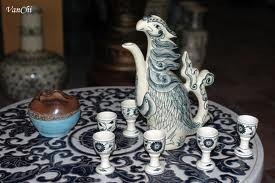(VOVworld) When talking about ancient pottery villages, one immediately thinks of Bat Trang, Hanoi’s ancient ceramic village. But another ancient pottery village named Chu Dau, thanks to a discovery made in the 1980s, is beginning to rival Bat Trang. Chu Dau’s ceramic craft, once famous worldwide, has been resurrected after disappearing for 3 centuries.
 |
| Modern Chu Dau ceramic wares |
The name Chu Dau literally means “wharf”. Chu Dau village in the northern province of Hai Duong was known only as a busy trading hub until evidence was uncovered that it used to produce ceramic vases that were renowned around the world. The story of Chu Dau’s revival as a ceramic village began with a 1980 letter from Makoto Anabuki, Secretary of the Japanese Embassy in Vietnam, to Ngo Duy Dong, Secretary of Hai Duong Province's Party Committee. In this letter, Anabuki wrote that during a working trip to Turkey, he had visited Topkapi Saray Museum in Istanbul and was very interested to see an ancient Vietnamese ceramic jar on display. On the jar was written: "In the Year of 1945 of the 8th Thai Hoa reign, a ceramic maker of the Bui Family in the Nam Sach area drew on this jar just for fun." Makoto Anabuki asked the Party Secretary to find the origin of this valuable jar 4 years later. From the information given, excavations uncovered relics proving that Chu Dau village used to produce ceramic products of high artistic merit. The discovery that wowed pottery experts also shocked the local residents. Nguyen Minh Tu, is a village elder of Chu Dau, says: "I never knew there were pottery kilns in this village although I sometimes found pieces of glazed terra-cotta in my garden. Only when experts came to my house and conducted excavations did I learn that those were pieces of national treasures. My fellow villagers and I are very happy and excited to receive experts, even foreign experts, to our village to research the village’s ancient craft of pottery."
In 1993 and 1997, at shipwreck sites in the Philippines’ Pandanan sea and near Vietnam’s Cham island, scientists found more than 340,000 porcelain objects from Chu Dau village, 240,000 of them unbroken. This proved that Chu Dau ceramic items were exported across the globe. Research has confirmed that Chu Dau’s ceramic craft was at its height from the 14th to the 17th century. There are currently 46 museums around the world displaying pottery products from Chu Dau village, some of the items worth as much as 1 million USD. In 2000, Nam Sach district native Nguyen Huu Thang, Director of the Saigon Haprosimex Company, wanted to revive Chu Dau as a ceramic village, copying excavated fine ceramic pieces for export and developing the village’s tourism potential. Villager Nguyen Van Luu was assigned the task of reviving the craft. He elaborated: "Our village’s ceramic craft has been highly praised by the international community. After much research, we decided it would be a very good thing to revive ancestors’ ancient craft. We believed this would generate jobs for many local people."
As part of this effort, in October, 2001, a Chu Dau ceramic workshop was established. Efforts were made to find and collect ancient ceramic pieces, and invite experts and artisans from other ceramic villages to collaborate on research into the colours of traditional ceramics. About 200 young people from Chu Dau Village were selected and taught the basic techniques and professional secrets of each production process. These apprentices will become expert artisans in the family ceramic groups of the future. From this workshop, many Chu Dau ceramic items have been exported globally, earning the villagers a better living now while paving the way for them to do even better when craft village tourism begins to spread their reputation to every corner of the world.
Tô Tuấn